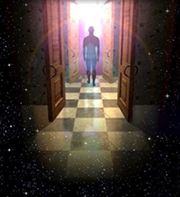Astronomers find the gate into parallel worlds
Only housewives believe in three-dimensional space. None of the serious scientists supports such a stupid idea “Whom would you like to clone?” was the theme of the recent survey conducted in the US and Great Britain. The most popular candidate turned out to be Albert Einstein, with Jesus Christ and Elvis Presley legging behind. Surprisingly enough, the famous physicist who created the theory of relativity to the fascination yet misunderstanding of the others was wrong. The only way to rescue poor Einstein is to agree that our world has more than three dimensions we are accustomed to.
“Whom would you like to clone?” was the theme of the recent survey conducted in the US and Great Britain. The most popular candidate turned out to be Albert Einstein, with Jesus Christ and Elvis Presley legging behind. Surprisingly enough, the famous physicist who created the theory of relativity to the fascination yet misunderstanding of the others was wrong. The only way to rescue poor Einstein is to agree that our world has more than three dimensions we are accustomed to.
Only housewives believe in three-dimensional space. None of the serious scientists would dare support such a stupid idea. However, the number of extra dimensions is still the object of heated discussions. Nature published an article by the Oxford professor Joseph Silk, where he makes a conclusion that there are six dimensions in the universe, i.e. three dimensions which we can sense and another three that we do not notice. For all its fantastic nature the theory of professor Silk turns out the least traumatic for a human mind and the easiest to grasp. The paradoxical theory of super cords that is growing in popularity suggests the existence of additional eight dimensions.
No matter how many extra dimensions there are, the fact that they exist is deduced from the strange behavior of the dark matter. These are particles of unknown nature that are still to be discovered but have been already predicted. They constitute 25 percent of our universe. 70 percent of the universe is formed by the so-called dark energy with positive density and negative pressure. Only three to five percent of the universe is the matter of protons, electrons and neutrons that is accessible to us. The mysterious dark matter that consists of particles heavier than proton is invisible to us. It gives itself away when affected by gravitation.
A group of scientists from Oxford analyzed the behavior of the dark matter in small galaxies and massive galaxy accumulations. They discovered that the dark matter draws substance in smaller objects, which does not happen in large objects for some reason, although the dark matter should exist there in large quantities according to the analysis of objects' spinning.
Professor Silk assumes that at a distance of about a nanometer three additional space dimensions distort gravitational effects and influence the interaction between the dark matter and other substance. However, in large galaxy groups particles of the dark matter move at a higher speed than those in dwarf galaxies. They are also farther from each other, which makes the effect of additional three dimensions insignificant.
As far as the theory of super cords is concerned it relieves the theory of relativity of several contradictions, which Einstein himself acknowledged but could not solve the problem though. The theory of super cords predicts the existence of new particle – graviton – that is similar to light photon and helps to understand the mechanism of gravitation influence. To this day nobody has succeeded in measuring speed at which gravity works.
The speed of electromagnetic coupling can be calculated unlike that of gravitation. According to Isaac Newton if the Sun suddenly disappeared from the Solar system, the Earth would become free of gravitation at once and rush into space. Einstein's theory says that if the speed of light equaled the speed of gravitation the Earth would stay in orbit for 500 seconds, which are needed for light and gravitation to cover the distance between the Sun and the Earth.
The Universe with gravitons has more dimensions than the ordinary world. But these eight new dimensions are a hard nut to crack. Peeping from our three-dimensional world we cannot see what is happening in the bright 11-dimensional world. Nevertheless, gravitation and gravity work directly through these additional dimensions.
For peace of mind, it must be said that these additional dimensions are tiny. Thus, only two or three of them may have sizes suitable for us.
Subscribe to Pravda.Ru Telegram channel, Facebook, RSS!



